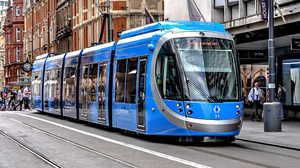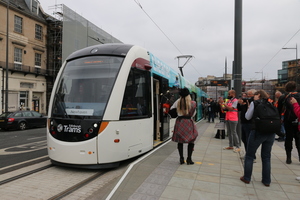
 |
Mark Sennett
Managing Editor |
 |
Kelly Rose
Editor |
| Home> | Managing Health & Safety | >Fleet & Driver Safety | >A safer approach |
A safer approach
22 July 2024
Light rail sector embraces data-led approach to risk reduction. Laura Reardon provides an insight.

LIGHT RAIL is already considered to be one of the safest modes of public transport, but the adoption of advanced modelling by UK tramways is transforming the way modern systems identify and manage potentially hazardous events.
The pioneering, data-based approach has been led by the Light Rail Safety and Standards Board (LRSSB), and its national Safety Risk Model is now being used by the UK’s seven second-generation systems to identify potential threats to the wellbeing of passengers, employees and anyone else who may come into contact with a tramway.
Through statistical analysis of previous incidents, the model provides both operators and the wider sector with a better understanding of all the safety risks associated with light rail operations and maintenance activities.
Exploiting data on previous incidents recorded by systems in Manchester, Nottingham, London, Edinburgh, Blackpool, South Yorkshire and the West Midlands, it also recognises the significance of potential low-frequency, high-consequence events.
Laura Reardon, the LRSSB’s head of safety risk management explained, “The development of the Safety Risk Model has been a key pillar of our work over the last few years, in response to recommendations made in a report into the 2016 Sandilands tragedy.
“Following the deaths of seven people and injuries to 62 others, when a tram derailed near Croydon, the Rail Accident Investigation Branch called for a systematic review of light rail operational risks and control measures, alongside the creation of a single organisation responsible for oversight of sector safety.
“As a result, the LRSSB was established by the sector under the guidance of the Department for Transport and the Office of Rail and Road, and since then the organisation has evolved to provide a sector-wide and comprehensive approach to tramway safety as part of a wider risk management and mitigation framework.
“This also includes an upgraded Tramway Accident and Incident Reporting system (TAIR), which has further helped the sector meet the RAIB’s recommendations.
“As the model and the reporting system were developed alongside each other, we were able to establish a common language for both data input and analysis, making it easier to account for a wide variation of network characteristics while removing a potential barrier to collaboration between them.”
Unique challenges
While every network faces many of the same fundamental risks, each has its own unique challenges, and these are highlighted by individual profiles within the wider Model.
For example, some tramways share a direct interface with mainline rail, while others operate in areas with a high number of visitors who may not be used to sharing the road with trams.
Each system may also employ different approaches towards revenue collection and protection and how on-board staff are deployed, making for a complex picture when it comes to managing risks.
However, the national model gives them a useful tool to help them meet the ‘excellence’ level within the Office of Rail and Road’s (ORR) Risk Management Maturity Model - a support tool that drives continuous improvement and a benchmark for health and safety management.
“In turn, unique risk profiles enable managers to make informed decisions on the allocation of resources, both in terms of time and money, to particular health and safety projects.”
An excellent example of this approach can be found in the West Midlands, where the operator of the region’s popular tramway invested around £200,000 on the installation of new infrastructure where modelling suggested there was an increased risk to pedestrians.
Anthony Stanley, head of operations and safety at West Midlands Metro commented, “Although the network has an excellent safety record, the model highlighted a risk of incidents involving collisions between members of the public and tram vehicles that was slightly higher than the sector average.
“As a result of the analysis of performance against the model, we embarked on a series of major infrastructure projects across the network. These included the installation of nearly 2 km of fencing at key locations where the tramway runs alongside footpaths, and additional pedestrian safety features at 10 non-motor user crossings.
“With the help and support of the LRSSB team and the model, we have significantly improved safety measures across our network.”
Ground-breaking research
At a national level, the model has also identified collisions with pedestrians as the number one safety risk faced by light rail operators. This prompted the LRSSB to commission ground-breaking research into why some pedestrians were missing existing measures put in place by operators to avoid such accidents.
For the first time, this research has provided nationwide data specific to light rail and found a host of factors at play - from pedestrians being complacent about crossing in front of a moving tram to distractions from mobile phones and a general lack of situational awareness.
In turn, the study has led to the launch of a national campaign that’s helping networks convey key safety messages to other road users. Blackpool Transport and Edinburgh Trams have already taken full advantage of eye-catching signage, social media posts and a host of other support from the LRSSB as part of the campaign.
Carl Williams, LRSSB chief executive explained: “From developing improved signage at crossing points to using the latest geolocation technology to alert members of the public of their proximity to the tracks, the campaign encourages innovative solutions to the most common cause of collisions on light rail systems.
“As it is rolled out nationally, we expect operators in other cities to lend their support to an initiative that’s set to deliver a major boost for light rail safety across the UK,”
Both the work being done in the West Midlands and the national campaign are clear examples of early successes for the risk model demonstrate its potential to revolutionise light rail safety, and it continues to evolve as more data is collected.
Laura continued: “The model has been ‘flexed’ over the past couple of years to take into account feedback from tramway safety professionals, and an updated template was rolled out late last year. This was done alongside a wholesale review of risk profiles carried out by individual networks.
“The key advancement for the model in recent months was the introduction of increased user-friendly results dashboards informed by the sector surveyed needs and tested by volunteer networks.”
The new Sector Safety Risk Model Dashboard provides insights into the risk profile for the total sector, and results can be interrogated to understand issues such as the top hazardous events for the sector; the distribution of risk across staff, members of the public and passengers; hazardous events with the highest risk of a fatality; and the breakdown of precursors contributing to risk.
A new individual benchmarking dashboard also allows users to reflect on their own risk profile in the context of the wider sector. For example, it can highlight their percentage risk contribution to the sector broken down by hazardous event, population or precursor; their safety risk model results anonymously ranked relative to other networks; and compare results normalised using variables such as the number of passenger journeys.
Benchmarking performance
The launch of the dashboards means that vital information is more readily available to those working to improve safety, providing data to drive decision-making while making it even easier for operators to benchmark their performance against other networks.
“These advances were made possible thanks to a milestone data sharing agreement within the sector, in collaboration with the ORR, that will also help support the sector’s research and innovation activities going forward,” Laura said.
Now the LRSSB is set to embark on further iterations of the results dashboards, as well as formalising a support strategy for networks to help them update their own risk models.
“Combined with other projects that make up our wider risk management and mitigation framework, the model provides another essential tool for the sector to use as it strives to make our light rail systems even safer.”
“Most importantly, the most recent model update has seen the estimated total collective risk for the sector reduced by over five per cent, the result of reductions in 42 of the 60 hazardous events within the risk model framework.
“These impressive results are now being recognised far beyond the UK light rail sector, with networks from as far afield as New Zealand and South Korea looking at adopting the LRSSB’s approach to data collection and modelling,” Laura added.
Laura Reardon is head of safety risk management at the Light Rail Safety and Standards Board. For more information, visit www.lrssb.org
- Stone kitchen worktop workshop caked in dust
- £100k fine for food processing firm
- Companies fined as electrician falls and fractures skull
- Stay safe when driving for work
- Fine after care home resident chokes and dies
- Risky Business - April 2019
- Taskforce tackles wellbeing in construction
- Kitchen fitter carried out illegal gas work
- Government's emission ambition needs real action
- Chemical company employee suffered multiple fractures

























